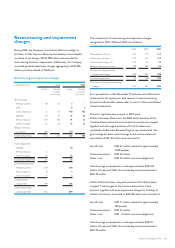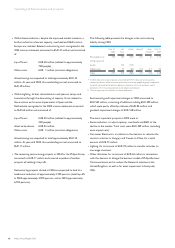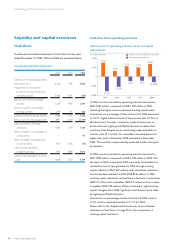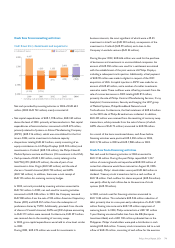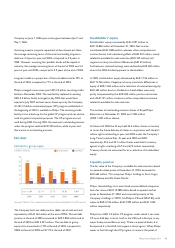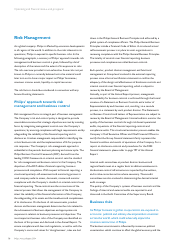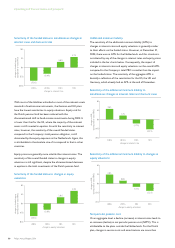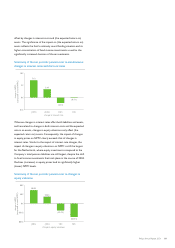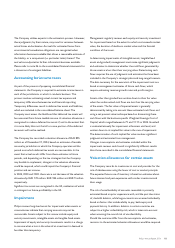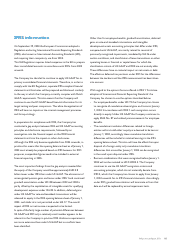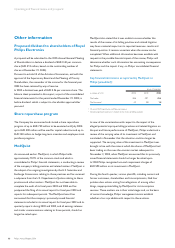Philips 2004 Annual Report Download - page 78
Download and view the complete annual report
Please find page 78 of the 2004 Philips annual report below. You can navigate through the pages in the report by either clicking on the pages listed below, or by using the keyword search tool below to find specific information within the annual report.international capital markets. Political and military developments
could have a material adverse effect on Philips’ results of
operations.
Philips’ overall performance in the coming years is strongly
dependent on realizing its growth ambitions in Asia,
especially China.
Besides representing a vital consumer market, China is also an
important production, sourcing and design center for Philips.
Philips faces strong competition to attract the best talent in a tight
labor market and intense competition from both local Chinese
companies as well as other global players for market share. To be
successful, Philips must leverage the investment in its global brand
positioning in the Chinese market to build greater consumer
preference.
A downturn in the cyclical market in which Semiconductors
operates, could adversely affect Philips’ results of
operations.
In 2004, continued efforts were made to implement a
capital-efficient strategy through increased use of ventures and
external sourcing.
Although the capital-efficient strategy should mitigate the impact of
cyclical market movements, a severe and sustained slowdown in
growth could negatively impact the loading of the manufacturing
base, leading to a fall in operational results.
If Philips is unable to ensure effective supply chain
management, the Company may be unable to sustain its
competitive position in its markets.
The businesses in which Philips is engaged are intensely
competitive. Accordingly, Philips continually faces competitive
challenges such as rapid technological change, evolving standards,
shortening product life cycles and price erosion. Initiatives to
reduce assets through outsourcing will require increased
management focus with respect to the supply base. The realization
of a world-class performance in supply chain management is
critical to success in the businesses concerned and is likely to
increase reliance on outsourcing.
Philips’ major challenge for the Lighting business is to secure
short-term profitability while simultaneously investing in
long-term growth strategies.
The industry is facing increased Chinese competition, which could
be exacerbated by a possible concentration of Chinese companies.
In order to mitigate this risk and be able to maintain short- and
medium-term profitability, Lighting needs to successfully grow in
new areas. In this context, a failure in one of the key drivers (being
end-user-driven innovation, marketing and supply excellence) and
more specifically in the introduction of added-value products such
as video projection systems, LCD backlighting and LED-based
lighting, could hamper the ability of the Lighting business to achieve
short- and medium-term growth ambitions. Long-term results will
be dependent on the development and marketing of new business
models, in particular of Solid-State lighting (SSL). The industry
could be drastically reshaped by the erosion of the traditional
lighting business as well as the entrance of new players. If Philips is
unable to adjust people competencies and capabilities in order to
pursue a more dynamic business model, its long-term results could
suffer.
If DAP is unable to pre-empt fundamental industry changes
or create sustainable, unique appliance/consumable
propositions, its current leadership positions might be
threatened.
The ambitions to expand in high-end and high-growth segments
will strongly depend on the ability to deliver best-in-class products
at competitive prices.
If Philips is not able to find new sources of differentiation in
the consumer electronics market, it may be unable to
sustain its competitive position in this market.
The industry trend towards digitalization is diminishing the
opportunities to differentiate on the basis of technical
performance and is fueling the emergence of new low-cost
Chinese and Taiwanese players in the market. Another trend is
the acceleration of entrants into the consumer electronics market
from the PC-IT industry. A critical success factor for the Company
to sustain its competitive position is the speed at which Philips is
able to implement its Connected Planet vision via the launch of a
broad range of integrated products in the segments of Connected
Displays, Home Entertainment Networks and Mobile
Infotainment. The successful completion of the Business Renewal
Program is another critical success factor for Consumer
Electronics.
Improvement in Medical Systems’ product creation process
and successful integration of new acquisitions are key to
Philips’ success in this business.
Further improvements in Medical Systems’ product creation
process, ensuring timely delivery of new products at lower costs
and upgrading of customer service levels to create sustainable
competitive advantage, are critical to realizing the profitable
growth ambitions in this segment of business, which is of
increasing importance in the overall Philips portfolio. To realize
Medical Systems’ growth ambitions, further acquisitions will be
required.
77Philips Annual Report 2004


